Rehabilitation - Kouseihogo

|
It refers to protection for those who have received some kind of judicial treatment, such as punishment or protective measures, due to delinquent or criminal behavior, with the aim of returning them to normal civilian life, and, in terms of criminal policy, preventing them from reoffending or re-offending. The legal system related to this is called the Rehabilitation Act (Probation Act). Before World War II, it was also called judicial protection. There are two types of probation: probation supervision, which is carried out regardless of the individual's will (authorized probation), and rehabilitation, which is carried out on the premise of the individual's will (rehabilitation in the narrow sense or non-authorized probation). Legislation mainly related to legal rehabilitation included the Offender Prevention and Rehabilitation Act (Act No. 142, 1949), the Probation Supervision Act for Persons on Suspended Execution of Sentence (Act No. 58, 1954), and the Offender Rehabilitation Law (Act No. 204, 1950), but in 2007, the former Offender Prevention and Rehabilitation Act and the Probation Supervision Act for Persons on Suspended Execution of Sentence were integrated into the Offender Rehabilitation Law (Act No. 88, 1997), which came into effect in 2008. In addition, legislation mainly related to offender rehabilitation in the narrow sense included the Emergency Offender Rehabilitation Law (Act No. 203, 1950), but this was abolished in 1995 and replaced by the Offender Rehabilitation Services Act (Act No. 86, 1995). [Masaaki Ogawa] HistoryThis type of business developed early in Europe and the United States. In Japan, the revised Prison Law of 1881 (Meiji 14) established a separate cell detention system that allowed those who had no "place to turn after the completion of their sentence" to stay in separate cells within the prison, but in 1889 this system was abolished for financial reasons and the system was left to private businesses. Well-known private businesses include the Shizuoka Prefecture Exterminator Protection Company (established in 1888) by Kinpara Meizen and the Hara Boarding House (established in 1897) in Kanda Jinbocho, Tokyo, by Hara Taneaki. The government encouraged this type of business, and in 1907 (Meiji 40) established the procedure for handling the grant for the Exemption Protection Business. The name "Judicial Protection Business" came into general use around the time the old Juvenile Law (1923) and the old Criminal Procedure Code (1924) were enacted. The Judicial Protection Services Act, enacted in 1939 (Showa 14) in order to strengthen measures to prevent recidivism, stipulated provisions such as specifying those to be protected, standardizing protection methods, and supervision and guidance of private protection organizations, but was abolished when the Emergency Rehabilitation Protection Act was enacted. [Masaaki Ogawa] Emergency rehabilitationThis refers to rehabilitation in the narrow sense. It is carried out to prevent recidivism and promote rapid rehabilitation after those who have completed their sentences, have been given a suspended sentence, or have been dismissed from prosecution, are released from physical restraints due to criminal proceedings. Based on the Offender Rehabilitation Services Act, continuous protection such as arranging for return to residence, providing money and goods, accommodation in certain facilities, necessary education, training, medical care, recreation, employment assistance, and environmental adjustments are provided by the probation office itself or entrusted to a person operating a rehabilitation services business, upon the request of the individual and when the director of the probation office deems it necessary, for a maximum of six months. Offender rehabilitation facilities are operated by private organizations such as offender rehabilitation corporations that operate rehabilitation services with the approval of the Minister of Justice, and the probation office provides guidance. In 2010, 12,675 people received emergency rehabilitation care at probation offices, and 4,199 people were entrusted to offender rehabilitation facilities. In addition to providing rehabilitation to those covered by the Offender Rehabilitation Services Act, offender rehabilitation facilities can also provide emergency medical care to those under probation under the commission of the probation office director. Since 2009, the Ministry of Justice and the Ministry of Health, Labour and Welfare have cooperated to implement a system to support homeless inmates who have difficulty living independently due to old age or disabilities in settling into local life. Offender rehabilitation facilities accept those who find it difficult to receive welfare support immediately after release, and provide guidance and training to help them prepare for the transition to welfare and adapt to social life. For this reason, designated offender rehabilitation facilities are equipped with staff with welfare qualifications and barrier-free facilities. [Masaaki Ogawa and Rie Yajima] "Sociology of Community-Based Treatment" by Ifukube Shunji (1993, Japan Rehabilitation Protection Association)" ▽ "Considerations on Community-Based Treatment" by Iwai Keisuke (1993, Japan Rehabilitation Protection Association)" ▽ "The Origins of Rehabilitation Protection" by Otsubo Yoichi (1996, Japan Rehabilitation Protection Association) ▽ "Hara Taneaki, the Father of Rehabilitation Protection" by Wakaki Masao (1996, Ozorasha) ▽ "Rehabilitation Protection Systems in Foreign Countries, vol. 1-4 (1997-2001, Rehabilitation Protection Bureau, Ministry of Justice)" ▽ "Practical Development of Rehabilitation Protection" by Suzuki Shoichiro (1999, Japan Rehabilitation Protection Association)" ▽ "People in the History of Rehabilitation Protection: Commemorating the 50th Anniversary of the Implementation of the Rehabilitation Protection System," edited by the Rehabilitation Protection Journal Editorial Committee, Rehabilitation Protection Bureau, Ministry of Justice (1999, Japan Rehabilitation Protection Association)" ▽ "50 Years of Offender Rehabilitation History Editorial Committee, ed., Issues and Prospects of Offender Rehabilitation: Collection of Essays Commemorating the 50th Anniversary of the Implementation of the Offender Rehabilitation System" (1999, Probation Bureau, Ministry of Justice)" ▽ "50 Years of Offender Rehabilitation History Editorial Committee, ed., 50 Years of Offender Rehabilitation: Offender Rehabilitation Walking Alongside the Local Community, vol. 1 and 2 (2000, National Association of Volunteer Probation Officers)" ▽ "Rehabilitation and Criminal Policy, by Tsunei Yoshinori (2002, Japan Offender Rehabilitation Association)" ▽ "Introduction to Offender Rehabilitation, edited by Matsumoto Masaru (2010, Seibundo)" ▽ "White Paper on Crime, edited by the Research and Training Institute of the Ministry of Justice, various editions (Printing Bureau, Ministry of Finance)" [References] | | | | | | | | |Source: Shogakukan Encyclopedia Nipponica About Encyclopedia Nipponica Information | Legend |
|
非行、犯罪などの行動に起因して刑罰とか保護処分など、なんらかの司法的処遇を受けた者について、その正常な市民生活への復帰と、一方、刑事政策的には再犯、再非行の防止を目的として行われる保護をいい、それに関する法の体系を更生法(更生保護法)という。第二次世界大戦前は司法保護ともよばれた。更生保護には、本人の意思にかかわらず行われる保護観察(有権的更生保護)と、本人の意思を前提として行われる更生保護(狭義の更生保護または非有権的更生保護)がある。主として有権的更生保護にかかわる立法として犯罪者予防更生法(昭和24年法律第142号)、執行猶予者保護観察法(昭和29年法律第58号)、保護司法(昭和25年法律第204号)があったが、2007年(平成19)、従来の「犯罪者予防更生法」と「執行猶予者保護観察法」を統合した「更生保護法」(平成19年法律第88号)が公布され、2008年に施行された。また、主として狭義の更生保護にかかわる立法として更生緊急保護法(昭和25年法律第203号)があったが、1995年に廃止され更生保護事業法(平成7年法律第86号)に改められた。 [小川政亮] 沿革この種の事業は欧米で早く発達した。日本では1881年(明治14)改正監獄則が「刑期満限ノ後頼ルヘキ所」のない者などに監獄内の別房への在留を許す別房留置制を定めたが、1889年に財政的理由でこれを廃止し、民間事業にゆだねることとした。民間事業としては金原明善(きんぱらめいぜん)による静岡県出獄人保護会社(1888年設立)や、原胤昭(はらたねあき)による東京・神田神保町(かんだじんぼうちょう)の出獄人保護所「原寄宿舎」(1897年設立)が知られる。政府はこの種の事業を奨励し、1907年(明治40)免囚保護事業奨励費取扱手続を定めた。旧少年法施行(1923)、旧刑事訴訟法施行(1924)のころから司法保護事業という名称が一般に用いられるようになった。再犯防止強化のためとして1939年(昭和14)制定の司法保護事業法は、保護対象者の明記、保護方法の標準化、民間保護団体に対する監督・指導などを定めたが、更生緊急保護法制定によって廃止された。 [小川政亮] 更生緊急保護狭義の更生保護のこと。懲役、禁錮などの執行を終えたり、執行を猶予されたり、不起訴処分になった者などが、刑事上の手続による身体の拘束を解かれたのち、再犯を防止し速やかな更生を保護するために行われる。更生保護事業法に基づき、帰住の斡旋(あっせん)、金品の給貸与などの一時保護や一定の施設での宿泊の供与、必要な教養、訓練、医療、保養、就職の援助、環境調整などの継続的保護が、本人の申し出があり、かつ保護観察所長が必要を認めたときに、6か月以内を限度に、保護観察所自らにより、または更生保護事業を営む者に委託して行われる。更生保護施設は、法務大臣の認可を受けて更生保護事業を営む更生保護法人などの民間団体によって運営され、保護観察所がその指導に当たる。2010年(平成22)、保護観察所において更生緊急保護を受けた者は1万2675人、更生保護施設に委託されたものは4199人である。 なお更生保護施設は、更生保護事業法による対象者に対する更生保護のほか、保護観察所長の委託を受けて保護観察を受けている者に対する応急の救護を行うこともできる。2009年度から、法務省と厚生労働省が連携し、高齢・障害により自立困難で住居のない受刑者等に対する地域生活定着支援制度が実施されており、更生保護施設は、出所後ただちに福祉による支援を受けることが困難な者を受け入れ、福祉への移行準備や社会生活に適応するための指導・訓練を行っている。そのため、指定された更生保護施設では、福祉専門資格を有する職員の配置やバリアフリー等の施設整備が行われている。 [小川政亮・矢嶋里絵] 『伊福部舜児著『社会内処遇の社会学』(1993・日本更生保護協会)』▽『岩井敬介著『社会内処遇論考』(1993・日本更生保護協会)』▽『大坪与一著『更生保護の生成』(1996・日本更生保護協会)』▽『若木雅夫著『更生保護の父原胤昭』(1996・大空社)』▽『『諸外国の更生保護制度』1~4(1997~2001・法務省保護局)』▽『鈴木昭一郎著『更生保護の実践的展開』(1999・日本更生保護協会)』▽『法務省保護局更生保護誌編集委員会編『更生保護史の人びと 更生保護制度施行五〇周年記念』(1999・日本更生保護協会)』▽『更生保護50年史編集委員会編『更生保護の課題と展望 更生保護制度施行50周年記念論文集』(1999・法務省保護局)』▽『更生保護50年史編集委員会編『更生保護50年史 地域社会と共に歩む更生保護』1、2(2000・全国保護司連盟)』▽『常井善著『更生保護と刑事政策』(2002・日本更生保護協会)』▽『松本勝編『更生保護入門』(2010・成文堂)』▽『法務省法務総合研究所編『犯罪白書』各年版(財務省印刷局)』 [参照項目] | | | | | | | | |出典 小学館 日本大百科全書(ニッポニカ)日本大百科全書(ニッポニカ)について 情報 | 凡例 |
<<: Synthetic preservatives - Synthetic preservatives
Recommend
Yoshikawa [Village] - Yoshikawa
A village in Kami County in the central eastern pa...
Embezzlement of entrusted goods - embezzlement of entrusted goods
Please see the "Embezzlement" page. Sou...
Face Height - Ganmenkou
…Facial height divided by facial width, a numeric...
Forklift - Forklift (English spelling)
A type of special cargo handling vehicle used for...
Kakunosuke Oyama
...He was a samurai of the Satsuma Domain during ...
Enkidu
… Gilgamesh was the lord of Uruk and was two-thir...
Santa Claus (English spelling)
Also spelled Santa Klaus. The name comes from Nich...
Grimmelshausen - Hans Jakob Christoffel von Grimmelshausen
German novelist. He is the author of The Fool'...
One-shot answer method - Ippa-kaitouhoshiki
...Since then, under this power, they have propos...
Akademee - Akademee
…As its name suggests, Demekin (Demekin) has larg...
Old Country Man Tadajii - Just an Old Man
?-? A comic writer in the mid-Edo period. He is s...
Sanshikiasagao (English name) three-color(u)red bindweed
An annual plant of the Convolvulaceae family nativ...
Ganpoji Temple
...Many people commute to Sukagawa and Koriyama. ...
Hargraves, EH
…However, by the 1940s, the acceptance of convict...
Emmerich Kálmán
A Hungarian-born composer. He was active mainly i...









